Page 17 of 86

Downloaded from www.Manualslib.com manuals search engine STEERING COLUMN CONTROLS
Anti-Theft Steering
Column Lock
The anti-theft lock, located on
the right side of the steering col
umn, has
five positions:
• Accessory -Permits opera
tion of electrical accessories
when engine
is not running. To
engage, push key in and turn
toward you (counterclockwise).
• Lock -Normal parking posi
tion. Locks ignition and pro
vides added theft protection by preventing
normal op
eration of steering wheel
and shift controls. Key
cannot be returned to
"lock" position and re
moved until transmis
sion
is placed in "park"
(automatic transmis
sion models) or in re
verse
on manual trans
mission models.
• Off - Permits turning engine
off without locking steering
wheel and shift controls.
• Run (ON) -Normal operating
position.
• Start -Permits engagement of
starter.
If difficulty is experienced in turn
ing the ignition key and lock knob
to unlock the ignition, attempt to
turn the steering wheel
as hard as
possible in the direction the wheels
are turned.
At the same time turn
15
NOTE: The anti-theft steering
column lock
is not a substitute
for the parking brake. Always
set the parking brake when leaving
the car unattended.
the ignition-lock knob in a clockwise
direction with
as much effort as you
can apply with your own hand.
Do
not attempt to use a tool of any kind I
to apply additional force on the lock
knob,
as this could break the knob.
Parking
When leaving your car unattended,
• Place automatic transmission
selector in
Park (Reverse for
manual transmission).
• Turn key to LOCK position.
• Set Parking brake.
• Remove key ( the buzzer will
remind
you).
• Lock all doors.
Starting Engine
Automatic Transmission
Models
1. Apply the foot brake.
Page 18 of 86
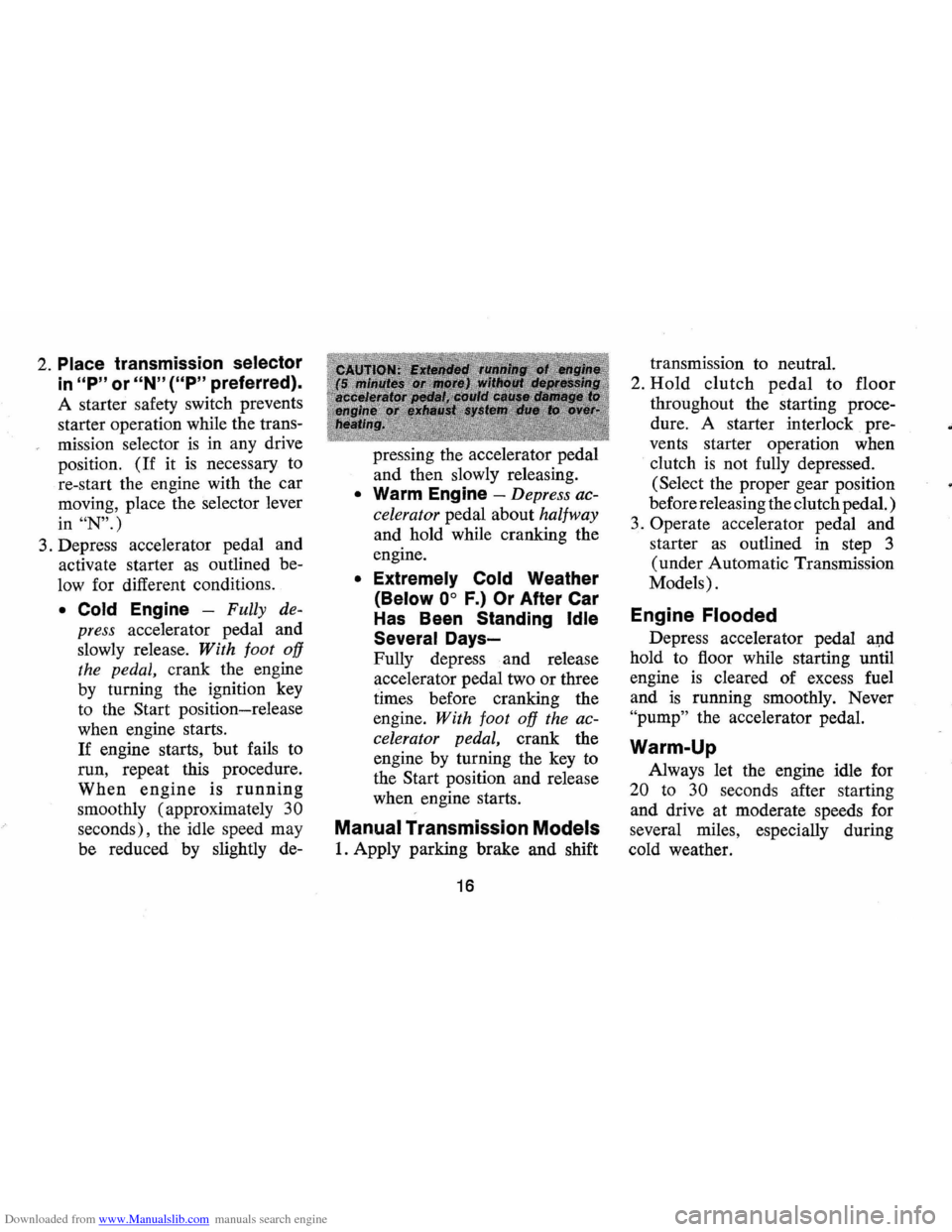
Downloaded from www.Manualslib.com manuals search engine 2. Place transmission selector
in uP" or uN" (UP" preferred).
A starter safety switch prevents
starter operation while the trans
mission selector
is in any drive
position.
(If it is necessary to
re-start the engine with the car
moving, place the selector lever
in
"N".)
3. Depress accelerator pedal and
activate starter
as outlined be
low for different conditions.
• Cold Engine -Fully de
press
accelerator pedal and
slowly release.
With foot off
the pedal, crank the engine
by turning the ignition key
to the Start position-release
when engine starts.
If engine starts, but fails to
run, repeat this procedure.
When engine is running
smoothly (approximately 30
seconds), the idle speed may
be reduced by slightly de- pressing
the accelerator pedal
and then slowly releasing.
• Warm Engine -Depress ac
celerator
pedal about halfway
and hold while cranking the
engine.
• Extremely Cold Weather
(Below 0° F.) Or After Car
Has Been Standing
Idle
Several
Oays-
Fully depress and release
accelerator pedal two or three
times before cranking the
engine.
With foot off the ac
celerator pedal,
crank the
engine by turning the key to
the Start position and release
when engine starts.
Manual Transmission Models
1. Apply parking brake and shift
16
transmission to neutral.
2.
Hold clutch pedal to floor
throughout the starting proce
dure.
A starter interlock pre
vents starter operation when
clutch
is not fully depressed.
(Select the proper gear position
before releasing the clutch pedal.)
3. Operate accelerator pedal and
starter
as outlined in step 3
(under Automatic Transmission
Models).
Engine Flooded
Depress accelerator pedal aJ;ld
hold to floor while starting until
engine
is cleared of excess fuel
and
is running smoothly. Never
"pump" the accelerator pedal.
Warm-Up
Always let the engine idle for
20 to 30 seconds after starting
and drive at moderate speeds for
several miles, especially during
cold weather.
Page 19 of 86
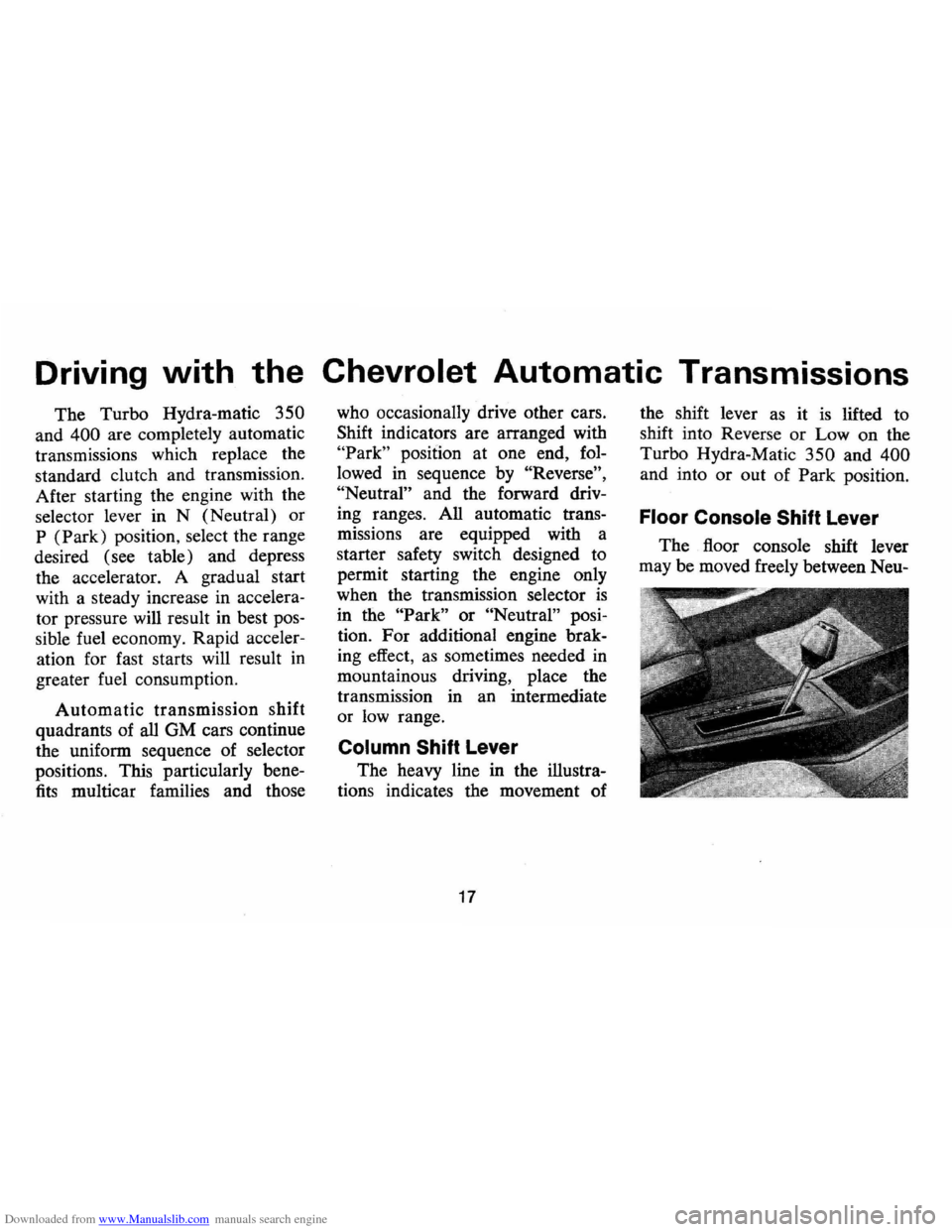
Downloaded from www.Manualslib.com manuals search engine Driving with the Chevrolet Automatic Transmissions
The Turbo Hydra-matic 350
and 400 are completely automatic
transmissions which replace the
standard clutch and transmission.
After starting the engine with the
selector lever in N (Neutral) or
P (Park) position, select the range
desired (see table) and depress
the accelerator. A gradual start
with a steady increase in accelera
tor pressure will result in best pos
sible fuel economy. Rapid acceler
ation for fast starts will result
in
greater fuel consumption.
Automatic transmission shift
quadrants of
all GM cars continue
the uniform sequence of selector
positions. This particularly bene
fits multicar families and those who
occasionally drive other cars.
Shift indicators are arranged with
"Park" position at one end, fol
lowed
in sequence by "Reverse",
"Neutral"
and the forward driv
ing ranges. All automatic trans
missions are equipped with a
starter safety switch designed to
permit starting the engine only
when the transmission selector
is
in the "Park" or "Neutral" posi
tion. For additional engine brak
ing effect,
as sometimes needed in
mountainous driving, place the
transmission in an intermediate
or
low range.
Column Shift Lever
The heavy line in the illustra
tions indicates the movement of
17
the shift lever as it is lifted to
shift into Reverse
or Low on the
Turbo Hydra-Matic
350 and 400
and into or out of Park position.
Floor Console Shift Lever
The floor console shift lever
may be moved freely between Neu-
Page 20 of 86
Downloaded from www.Manualslib.com manuals search engine tral and Drive and between 1 and
2. Press the shift lever button lo
cated on top of the shift lever
as
you shift into Reverse or from
Drive into 2. Depress the button
on top of the handle fully when shifting
into or out of the Park
position. Exercise care when de
pressing button to prevent unin
tentional shifts to
Park or Reverse.
Turbo Hydra-Matic Automatic Transmission
P-PARK
R-REVERSE
Console N-NEUTRAL
3 O-DRIVE
2 L,-LOW,
1 L,-LOW,
18
Use only when car is stopped.
For backing
car-from stop.
For standing (Brakes
Applied).
For forward driving.
Depress accelerator to floor for extra
acceleration below
65 mph; depress
accelerator half-way at speeds below
30 mph.
For driving
in heavy traffic or on hilly terrain. Shift into 2 or L, at any
vehicle speed.
For hard pulling through sand, snow
or mud, and for climbing or descend
ing steep grades.
Page 21 of 86
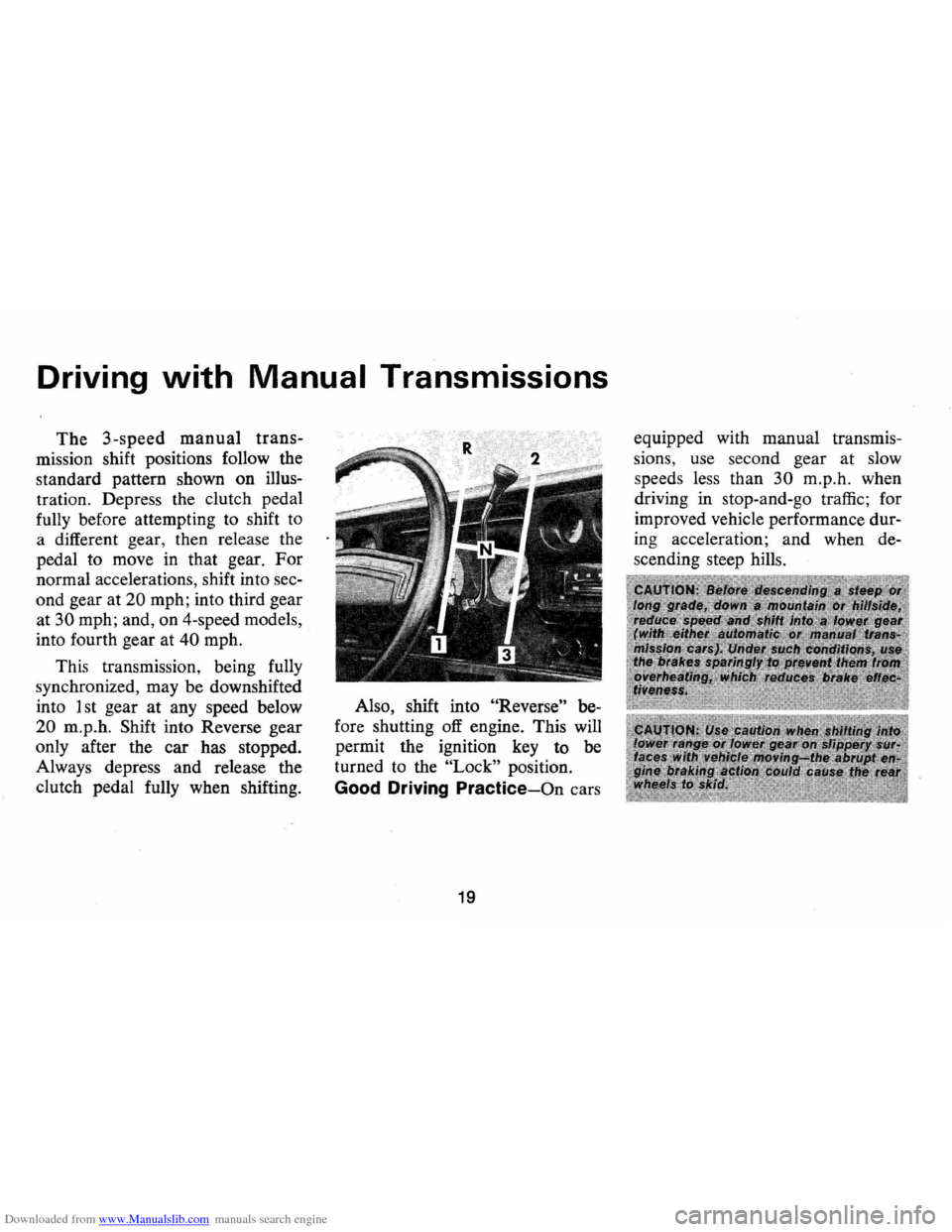
Downloaded from www.Manualslib.com manuals search engine Driving with Manual Transmissions
The 3-speed manual trans
mission shift positions follow the
standard pattern shown on illus
tration. Depress the clutch pedal
fully before attempting to shift
to
a different gear, then release the
pedal to move in that gear.
For
normal accelerations, shift into sec
ond gear at
20 mph; into third gear
at
30 mph; and, on 4-speed models,
into fourth gear at
40 mph.
This transmission, being fully
synchronized, may be downshifted
into 1 st gear
at any speed below
20 m.p.h. Shift into Reverse gear
only after the car has stopped.
Always depress and release the
clutch pedal fully when shifting. Also,
shift into
"Reverse" be
fore shutting
off engine. This will
permit the ignition key to be
turned to the
"Lock" position.
Good Driving Practice-On cars
19
equipped with manual transmis
sions, use second gear at slow
speed s less than
30 m.p .h. when
driving in stop-and-go traffic; for
improved vehicle performance dur
ing acceleration; and when de
s cending steep hills.
Page 22 of 86
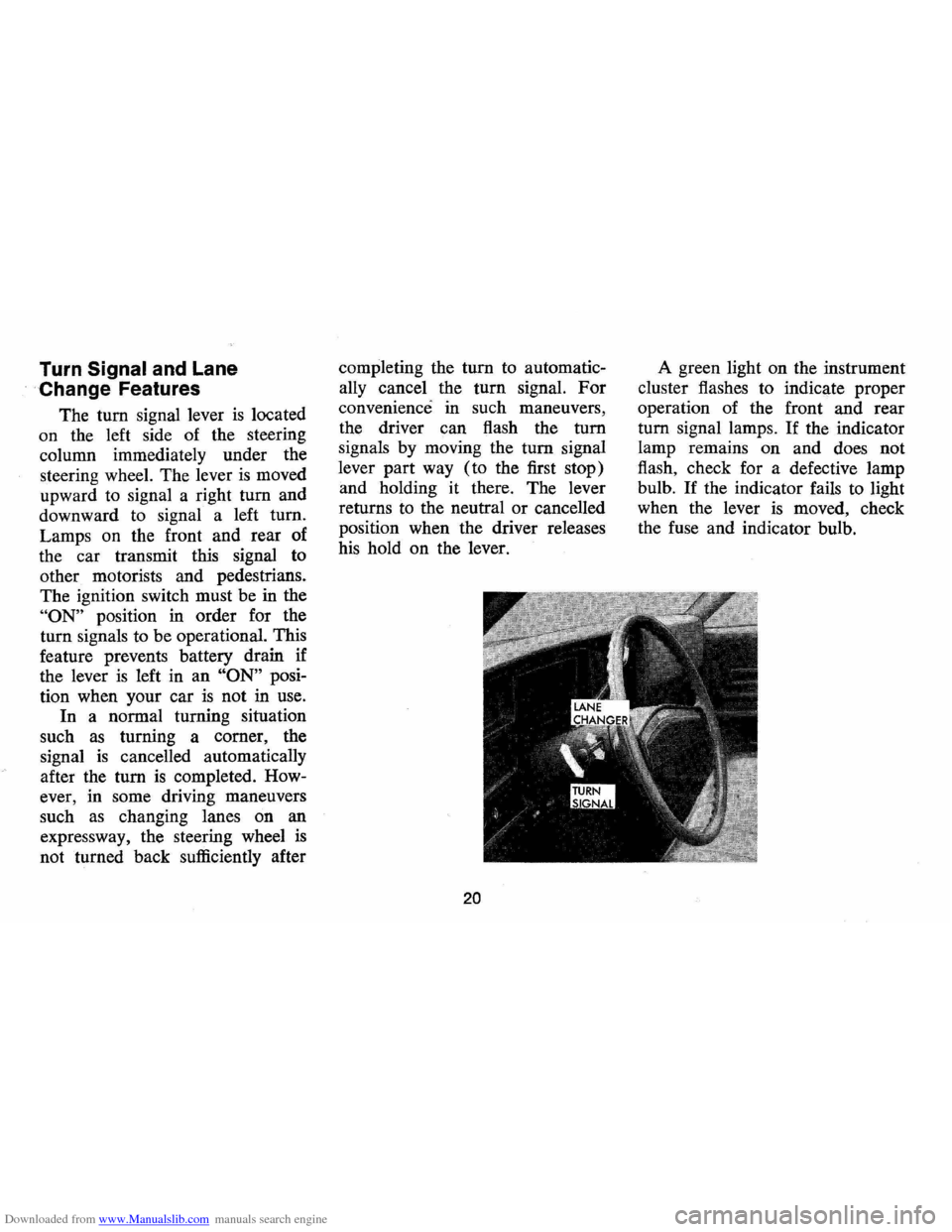
Downloaded from www.Manualslib.com manuals search engine Turn Signal and Lane
. Change Features
The tum signal lever is located
on the left side of the steering
column immediately under the
steering wheel. The lever
is moved
upward to signal a right
tum and
downward to signal a left tum.
Lamps on the front and rear of
the car transmit this signal to
other motorists and pedestrians.
The ignition switch must be in the
"ON" position in order for the
turn signals to be operational. This
feature prevents battery drain if
the lever
is left in an "ON" posi
tion when your car
is not in use.
In a normal turning situation
such
as turning a comer, the
signal
is cancelled automatically
after the tum
is completed. How
ever, in some driving maneuvers
such
as changing lanes on an
expressway, the steering wheel
is
not turned back sufficiently after completing
the
tum to automatic
ally cancel the turn signal.
For
convenience in such maneuvers,
the driver can flash the
tum
signals by moving the tum signal
lever part way (to the first stop)
and holding it there. The lever
returns to the neutral
or cancelled
position when the driver releases
his hold on the lever.
20
A green light on the instrument
cluster flashes to indicate proper
operation of the front and rear
tum signal lamps. If the indicator
lamp remains on and does not
flash, check for a defective lamp
bulb.
If the indicator fails to light
when the lever
is moved, check
the fuse and indicator bulb.
Page 23 of 86
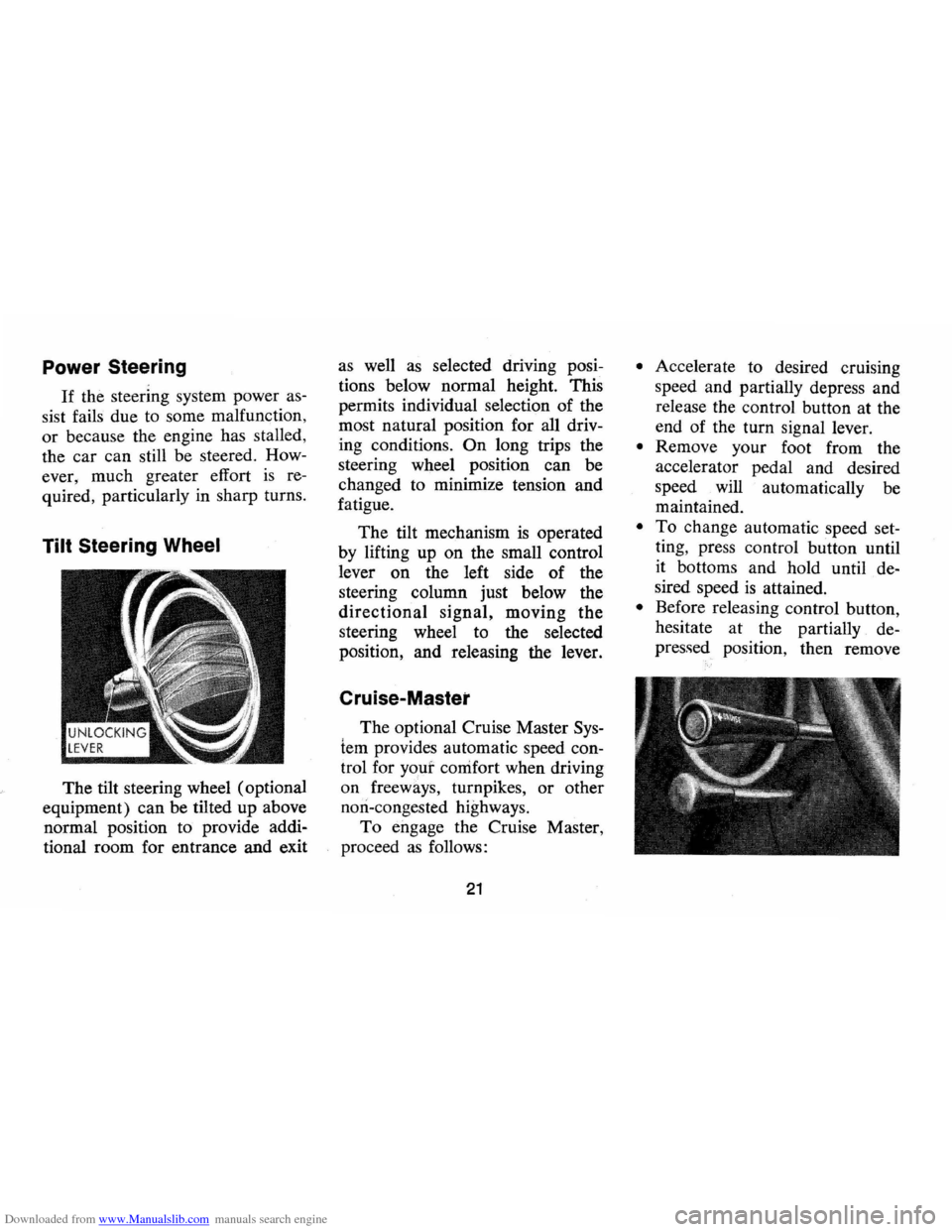
Downloaded from www.Manualslib.com manuals search engine Power Steering
If the steering system power as
sist fails due to some malfunction,
or because the engine has stalled,
the car can still be steered. How
ever, much greater effort
is re
quired, particularly in sharp turns.
Tilt Steering Wheel
The tilt steering wheel (optional
equipment) can be tilted up above
normal position to provide addi
tional room for entrance and exit as
well
as selected driving posi
tions below normal height. This
permits individual selection of the
most natural position for all driv
ing conditions.
On long trips the
steering wheel position can be
changed to minimize tension and
fatigue.
The tilt mechanism
is operated
by lifting up on the small control
lever
on the left side of the
steering column just below the
directional signal, moving the
steering wheel to the selected
position, and releasing the lever.
Cruise-Master
The optional Cruise Master Sys
tem provides automatic speed con
trol for
your comfort when driving
on freeways, turnpikes, or other
non-congested highways.
To engage the Cruise Master,
proceed
as follows:
21
• Accelerate to desired crUIsmg
speed and partially depress and
release the control button at the
end of the turn signal lever.
• Remove your foot from the
accelerator pedal and desired
speed will automatically be
maintained.
• To change automatic speed set
ting , press control button until
it bottoms and hold until de
sired speed
is attained.
• Before releasing control button,
hesitate at the partially de
pressed position, then remove
Page 24 of 86
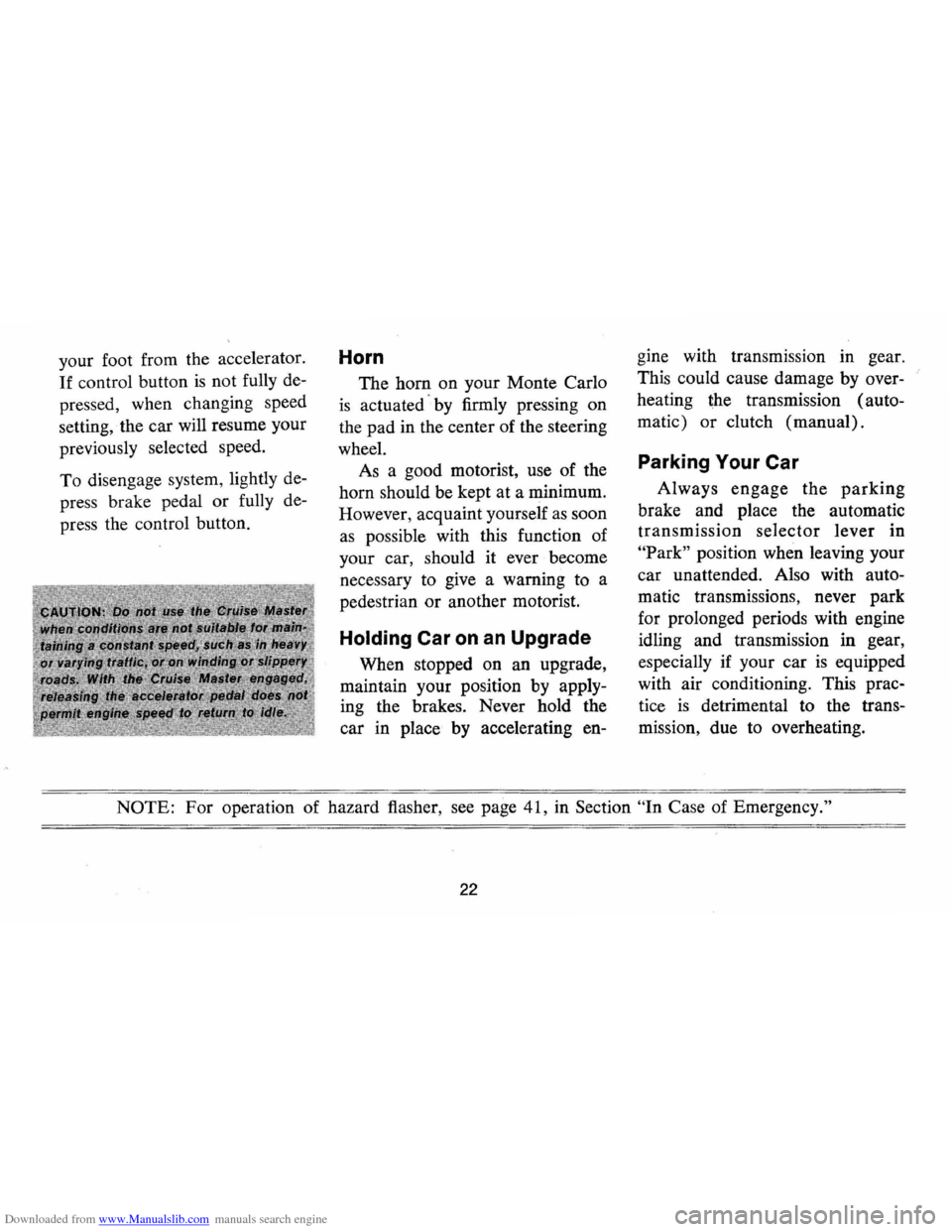
Downloaded from www.Manualslib.com manuals search engine your foot from the accelerator.
If control button is not fully de
pressed, when changing speed
setting,
. the car will resume your
previously selected speed.
To disengage system, lightly de
press brake pedal or fully de
press the control button.
Horn
The hom on your Monte Carlo
is actuated · by firmly pressing on
the pad in the center of the steering
wheel. As a good motorist, use of the
horn should be kept at a minimum.
However, acquaint yourself
as soon
as possible with this function of
your car, should it ever become
necessary to give a warning to a
pedestrian
or another motorist.
Holding Car on an Upgrade
When stopped on an upgrade,
maintain your position by apply
ing the brakes. Never hold the
car in place by accelerating en-gine
with transmission in gear.
This could cause damage by over
heating the transmission (auto
matic)
or clutch (manual).
Parking Your Car
Always engage the parking
brake and place the automatic
transmission selector lever in
"Park" position when leaving your
car unattended. Also with auto
matic transmissions, never park
for prolonged periods with engine
idling and transmission in gear,
especially if your car
is equipped
with air conditioning. This prac
tice
is detrimental to the trans
mission, due to overheating.
NOTE: For operation of hazard flasher, see page 41, in Section "In Case of Emergency."
22